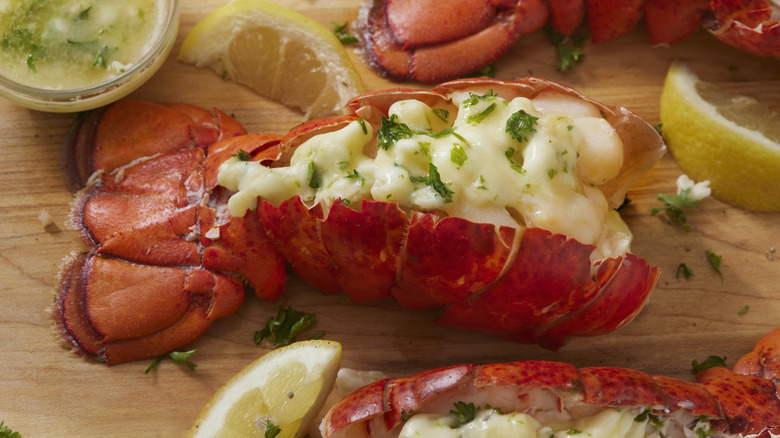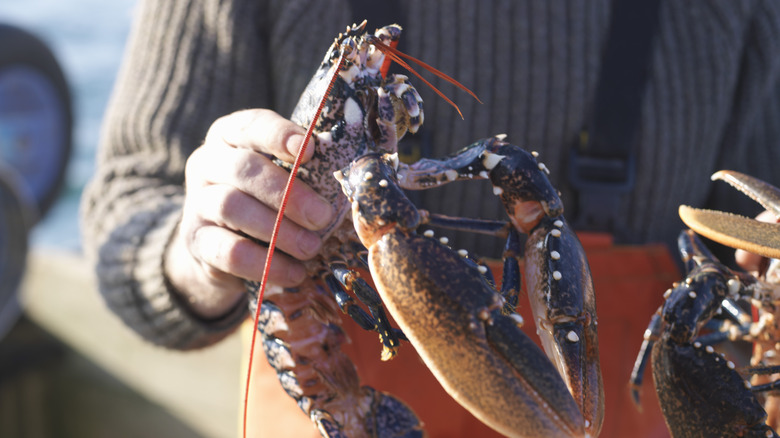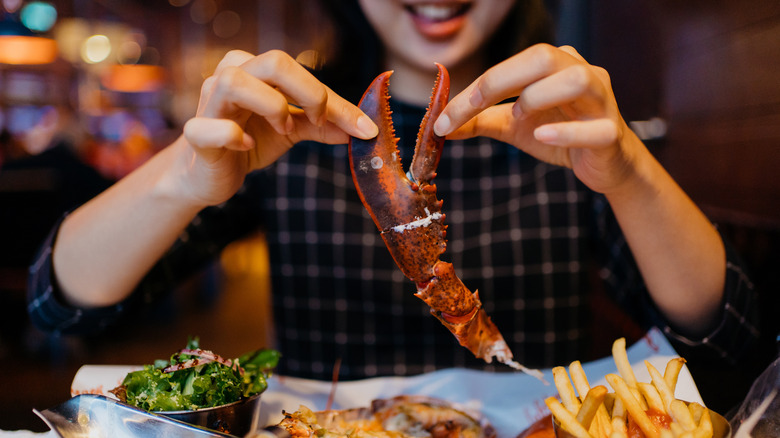What Is The White Stuff On My Lobster?
For most of us, preparing a lobster dinner at home is a rarity. This not only makes the meal more special — it can also leave us somewhat confused or concerned when something unexpected comes up during the cooking process. While chicken, beef, and seafood options like shrimp and fish are probably familiar territory for most omnivorous home chefs, lobster comes with some unique surprises up its sleeve.
For example, did you know that you're likely to encounter a congealed white goop when making lobster at home? Sometimes this substance shows up in the water you're boiling the crustaceans in, or it may be inside the shell when you crack it open to enjoy your meal. Although encountering it may be an unpleasant surprise, it's not an indication that your lobster is past its prime or otherwise unsafe to eat — this white stuff is simply the lobster equivalent of blood, called hemolymph. Not only is its presence perfectly natural, but it's actually a good sign, signaling that you're about to eat a fresh, flavorful, delicious seafood dinner.
What is hemolymph?
While the majority of animals — though not all — have hearts, the circulatory systems that keep them pumping do not work the same way. Among vertebrates, or animals with spines, and even many invertebrates, closed circulatory systems distribute blood throughout the body via blood vessels. However, some invertebrates, including crustaceans, have an open circulatory system. This means that a lobster's blood enters and exits the heart through small holes called ostia, and moves through seven arteries into the main body cavity. Once in the open cavity, the lobster's blood interacts directly with the animal's tissues.
But their blood isn't technically blood. It's hemolymph, which is the lobster's circulatory fluid, equivalent to the blood found in vertebrates. Comprised primarily of water, the hemolymph also carries proteins, carbohydrates, lipids, and nutrients around the animal's body, bathing organs and conducting gas exchange while simultaneously helping to remove any toxins or waste within the body.
Is hemolymph safe to eat?
In the same way that we find blood within the body cavities and muscles of a chicken, cow, or pig, the white hemolymph within the lobster is a perfectly normal part of eating meat — and it's as safe to consume as the blood of any other healthy animal. Unlike invertebrates with closed-circulatory systems and the red blood we are familiar with, hemolymph is an opaque fluid that solidifies as the animal is cooked, resulting in a white substance that almost resembles fat.
While this reaction may be new to you, lobster's hemolymph works to enhance the flavor of the meat, just as blood does in steak. Feel free to eat it as part of your lobster dinner, or blend it into a sauce or soup to add a rich lobster flavor to another dish. If you find the congealed hemolymph unsettling or unappetizing in any way, you shouldn't have any difficulty avoiding it altogether. You can choose to eat around any that you find within the shell, or rinse the lobster off under warm water and dry it with a clean towel before serving. Whether you intend to simply enjoy the lobster tails dipped in butter, or plan to make something more elaborate like a decadent lobster Thermidor, you're sure to enjoy this spectacular ingredient. Choose the best drink pairing for your lobster dish, and enjoy!



